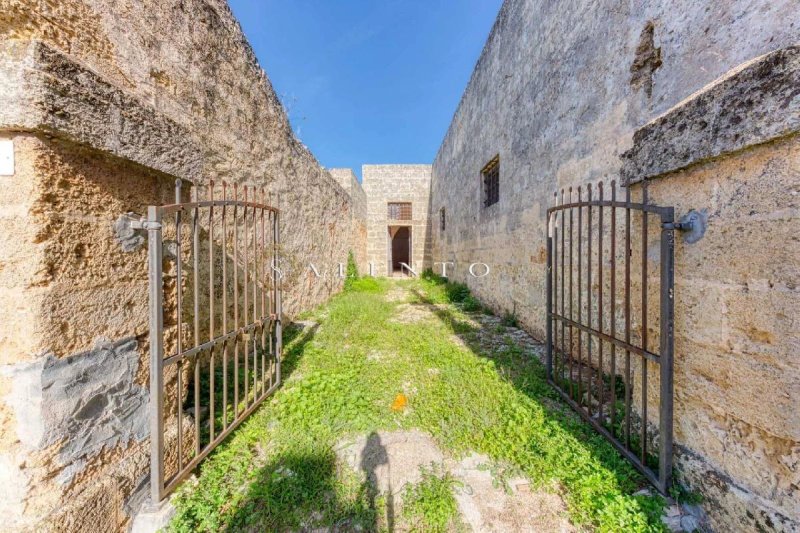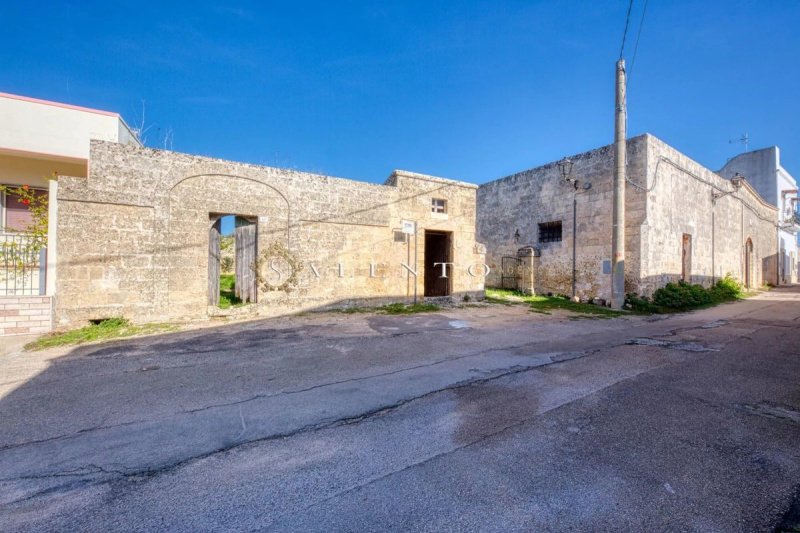Salento Agency, is pleased to present the sale of a beautiful property located in the historic center of Giuliano di Lecce, a characteristic village of Capo di Leuca, falling within the Municipality of Castrignano del Capo. It is assumed that the origins of Julian are Roman, from the name of "Ager Julianus" (farm of a Julius). Giuliano has historically noble and fascinating origins that link his life to that of the noble dynasty that owned it. The feudal Castello di Giuliano was built in the early sixteenth century in the ancient heart of the town. The fortress is one of the few in Salento to have kept its original appearance intact. The castle has the characteristics of military architecture of the sixteenth century. The main façade, on the sides of which rise two square shaped towers, is characterized by curtains and four high vertical bastions. A large arched bridge, which crosses the moat, allows access to the inside of the castle. The structure is distributed around a large central courtyard overlooked by all the rooms on the ground floor and first floor. The ground floor, intended for production activities, houses the stables, stables, warehouses and rooms for the servants; the upper floor, intended instead for the residence of the feudal lord, houses the noble rooms. The menhir Mensi, located in the historic center of the village, in the ancient Via Regina Elena, is one of the few remaining examples in the Capo di Leuca. Made in local carparo, it has a height of 2.34 meters; its characteristic is to be surmounted by a small horizontal slab. The property for sale is located in Via Regina Elena.
The real estate complex consists of rooms on the ground floor and an ancient underground oil mill built in 1789 (time of the French Revolution), by visiting this property you can enjoy the transition from agricultural society to the industrial revolution.
The underground oil mill is obviously located in the basement and still retains a beautiful stone mill and the milling tank.
The underground oil mills dug by hand in the tuffaceous lands are always equipped with rooms for storing oil and niches where the workers rested on the straw beds.
Entering the rooms on the ground floor you can see the first machines used for the milling of Olives. Large rooms with typical star vaults were used for hydraulic presses, while a room with a barrel vault and fireplace was the accountant's study.
A second large room made up of three star vaults was the room where the olives to be milled were stored and adjacent there were two rooms with tubs in Lecce stone where the oil produced was stored. In the rear part there was the galley and a storage room. A large courtyard separated the processing rooms with the three rooms for livestock and agricultural tools. In the rear part a large garden of 400 meters, accessible from Via Frosinone.--bbf4db165024e4e4dfc39815ebf51fff!
自动翻译所用的语言
Salento Agency, è lieta di presentarvi la vendita di una bellissima struttura situata nel centro storico di Giuliano di Lecce, caratteristico borgo del Capo di Leuca, ricadente nel Comune di Castrignano del Capo. Si presume che le origini di giuliano siano romane, dal nome da "Ager Julianus" (podere di un Giulio). Giuliano ha storicamente nobili e affascinanti origini che legano la sua vita a quella della dinastia nobile che l'ha posseduta. Il feudale Castello di Giuliano, fu edificato nei primi anni del XVI secolo nel cuore antico del paese. La fortezza è una delle poche nel Salento ad avere mantenuto l'originaria fisionomia intatta. Il castello presenta i caratteri propri dell'architettura militare del Cinquecento. Il prospetto principale, ai cui lati si elevano due torrioni di forma quadrata, è caratterizzato da cortine e da quattro alti bastioni verticali. Un ampio ponte ad archi, che supera il fossato, permette l'accesso all'interno del castello. La struttura è distribuita intorno a un ampio cortile centrale sul quale si affacciano tutti gli ambienti del piano terra e del primo piano. Il piano terra, destinato alle attività produttive, ospita le scuderie, le stalle, i depositi e i locali per la servitù; il piano superiore, destinato invece alla residenza del feudatario, ospita le stanze nobiliari
Il menhir Mensi, situato nel centro storico del borgo, nell'antica Via Regina Elena, è uno dei pochi esemplari rimasti nel Capo di Leuca. Realizzato in carparo locale, ha un'altezza di 2,34 metri; la sua caratteristica è quella di essere sormontato da una piccola lastra orizzontale.
Proprio in Via Regina Elena è situata la proprietà in vendita.
Il complesso immobiliare è composto da dei locali al piano terra e da un antico frantoio ipogeo edificato nel 1789 (epoca della rivoluzione francese), visitando questa proprietà potrete assaporare il passaggio dalla società agricola alla rivoluzione industriale.
Il frantoio ipogeo ovviamente è situato al piano interrato e conserva ancora una bellissima macina in pietra e la vasca di molitura.
I frantoi ipogei scavati a mano nei terreni tufacei sono sempre dotati di stanze per lo stoccaggio dell'olio e nicchie dove gli operai si riposavano sui letti di paglia.
Entrando nei locali al piano terra si notano i primi macchinari utilizzati per la molitura delle olive.
Grandi ambienti con tipiche volte a stella erano destinati alle presse idrauliche, mentre una stanza con la volta a botte e il camino era lo studio del contabile.
Un secondo grande locale formato da tre volte a stella era il locale dove venivano stoccate le olive da molire e in adiacenza vi erano due stanze con le vasche in pietra leccese dove veniva stoccato l'olio prodotto. Nella parte retrostante c'era la cambusa e un locale deposito.
Un grande cortile separava i locali di lavorazione con i tre ambienti destinati al bestiame e agli attrezzi agricoli. Nella parte retrostante un grande giardino di 400 metri, accessibile da Via Frosinone.
L'agence Salento a le plaisir de vous présenter la vente d'une belle propriété située dans le centre historique de Giuliano di Lecce, un village caractéristique de Capo di Leuca, relevant de la municipalité de Castrignano del Capo. On suppose que les origines de Julien sont romaines, du nom de « Ager Julianus » (ferme d'un Julius). Giuliano a des origines historiquement nobles et fascinantes qui lient sa vie à celle de la noble dynastie qui en était propriétaire. Le château féodal de Giuliano a été construit au début du XVIe siècle dans l'ancien cœur de la ville. La forteresse est l'une des rares du Salento à avoir conservé son aspect d'origine. Le château présente les caractéristiques de l'architecture militaire du XVIe siècle. La façade principale, sur les côtés de laquelle s'élèvent deux tours carrées, est caractérisée par des courtines et quatre hauts bastions verticaux. Un grand pont en arc, qui enjambe les douves, permet d'accéder à l'intérieur du château. La structure est distribuée autour d'une grande cour centrale surplombée par toutes les pièces du rez-de-chaussée et du premier étage. Le rez-de-chaussée, destiné aux activités de production, abrite les écuries, les étables, les entrepôts et les chambres des domestiques ; l'étage supérieur, destiné à la résidence du seigneur féodal, abrite les chambres nobles.Le menhir Mensi, situé dans le centre historique du village, dans l'ancienne Via Regina Elena, est l'un des rares exemples restants dans le Capo di Leuca. Fabriqué en carparo local, il a une hauteur de 2,34 mètres ; sa caractéristique est d'être surmontée d'une petite dalle horizontale.La propriété à vendre est située dans la Via Regina Elena.
L'ensemble immobilier se compose de pièces au rez-de-chaussée et d'un ancien moulin à huile souterrain construit en 1789 (époque de la Révolution française), en visitant cette propriété vous pourrez apprécier le passage de la société agricole à la révolution industrielle.
Le moulin à huile souterrain est évidemment situé au sous-sol et conserve encore un beau moulin en pierre et la cuve de mouture.
Les moulins à huile souterrains creusés à la main dans les terres tufacées sont toujours équipés de salles pour stocker l'huile et de niches où les ouvriers se reposaient sur les lits de paille.
En entrant dans les salles du rez-de-chaussée, on peut voir les premières machines utilisées pour le broyage de Olives De grandes salles avec des voûtes en étoile typiques étaient utilisées pour les presses hydrauliques, tandis qu'une salle avec une voûte en berceau et une cheminée servait de bureau au comptable.
Une deuxième grande pièce composée de trois voûtes en étoile était la pièce où étaient stockées les olives à moudre et adjacentes se trouvaient deux pièces avec des cuves en pierre de Lecce où l'huile produite était stockée. Dans la partie arrière, il y avait la cuisine et une salle de stockage.Une grande cour séparait les salles de traitement des trois salles pour le bétail et les outils agricoles. Dans la partie arrière un grand jardin de 400 mètres, accessible depuis la Via Frosinone.--bbf4db165024e4e4dfc39815ebf51fff!


